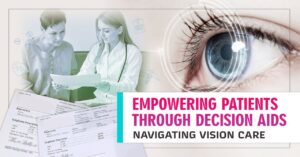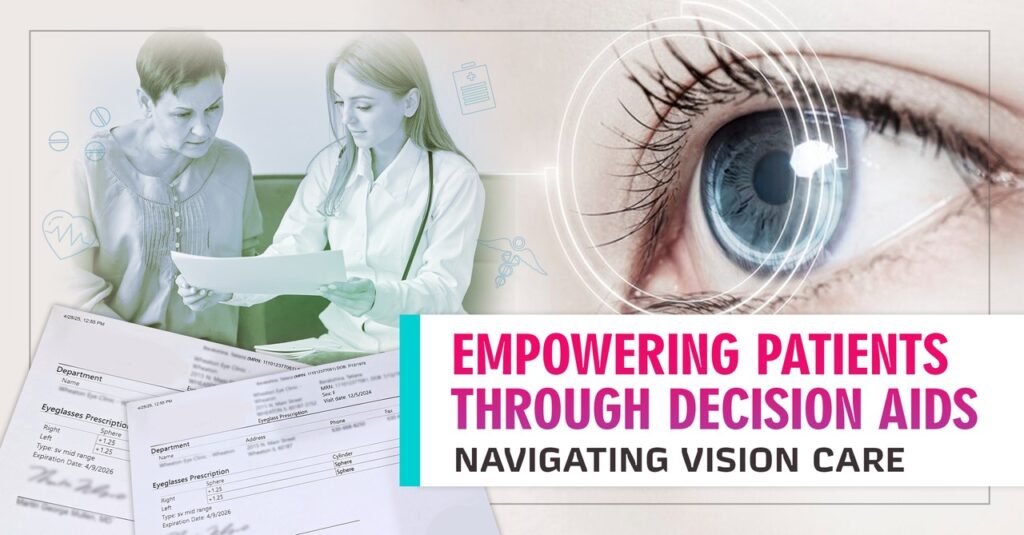
Shared Decision Making with Decision Aids: Navigating Vision Care

Welcome to our new series exploring Patient Decision Aids and their transformative potential across healthcare. At Bazis Americas, we’ve developed a deep passion for these tools and their ability to educate patients on their healthcare options. For our first piece, we’re diving into ophthalmology — a field where complex terminology often creates barriers between providers and patients.
When Medical Jargon Creates Confusion
Have you ever stood at an optical counter, prescription in hand, wondering why the numbers on paper don’t match your actual visual experience? You’re hardly alone. The terminology used in Ophthalmology functions like a specialized dialect—it’s intuitive to practitioners but often confusing to those receiving care.
This communication gap isn’t merely inconvenient; it strongly affects treatment outcomes and patient satisfaction. As healthcare evolves toward greater patient autonomy, these communication barriers become increasingly problematic.
The Prescription Challenge: A Patient’s Journey to Clarity
Recently, we encountered a scenario that perfectly captures this gap in communication. A patient who had undergone LASIK for farsightedness correction found themselves struggling with near vision while working on their laptop. Their solution seemed straightforward: outfit their favorite red frames with prescription lenses.
What followed was a month-long journey of frustration. The optical shop insisted on a current prescription, which came back as +2.25. However, the patient’s personal experience with over-the-counter readers suggested +1.25 worked better. Multiple visits ensued, with confusing directives coming from different providers.
The breakthrough came unexpectedly. During a follow-up, the patient mentioned their extensive computer work to a nurse who then explained what should have been communicated from day one:
“Reading glasses are calibrated for close-up tasks about 16 inches away. Computer glasses are entirely different—designed for intermediate distances between 20 and 26 inches.”
This simple explanation made everything clear. The higher prescription targeted traditional reading distance, while the patient primarily needed correction for screen viewing at arm’s length.
Seeing Solutions: How Decision Aids Can Change Patient-Centered Care
This patient’s journey highlights exactly why decision aid tools matter. When clinicians and patients lack shared vocabulary or contextual understanding, even straightforward care becomes needlessly complicated.
Imagine instead if this patient had accessed an interactive decision aid upon their initial post-LASIK consultation. Such a tool might have:
- Asked detailed questions about daily visual requirements and screen usage
- Explained the crucial difference between reading and computer glasses in plain language
- Generated personalized recommendations based on lifestyle needs
- Provided printable guidance for discussions with optical providers
- Offered visual simulations of different prescription strengths
The healthcare journey would have transformed from frustrating to empowering.
Some companies are already taking steps in the right direction. Zenni Optical, for instance, offers an excellent resource that helps patients understand how to read their eye prescriptions, breaking down complex terminology into accessible language.
Beyond Vision: The Future of Patient-Centered Care
This ophthalmology example represents just one facet of a much larger healthcare communication challenge. Whether selecting diabetes management approaches, weighing cancer treatment options, or making end-of-life care decisions, patients frequently navigate complex choices without adequate tools.
At Bazis Americas, we believe decision aids represent a big step in patient-centered care. They don’t replace clinician expertise—they enhance it by creating informed patients ready to participate meaningfully in their own care decisions.
In our next blog, we’ll explore innovative decision aid implementations across multiple medical areas, examine what makes them effective and discuss how they change patient experiences. Stay tuned as we continue sharing how these tools are reshaping healthcare communication.



